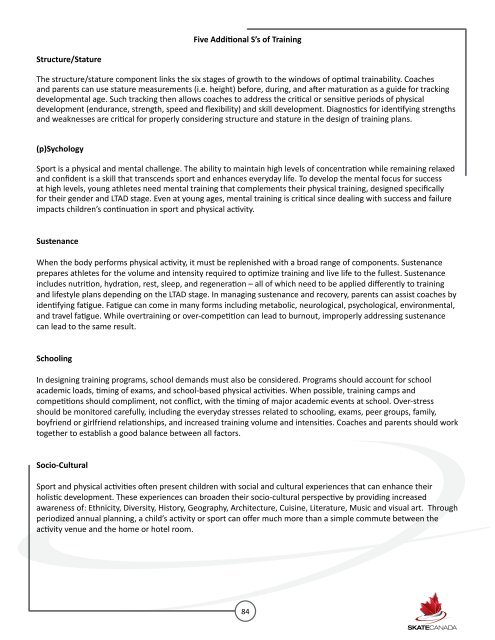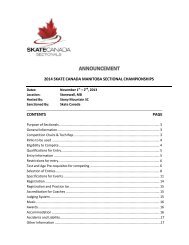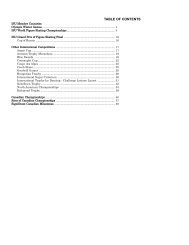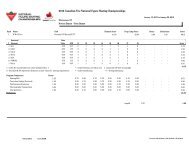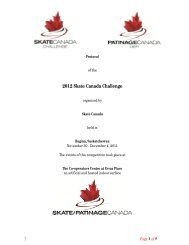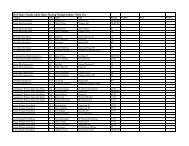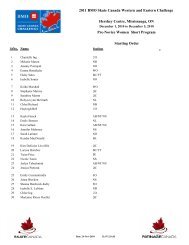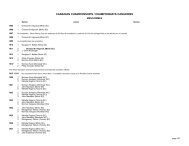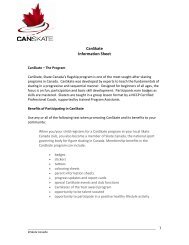LONG-TERM ATHLETE DEVELOPMENT - Skate Canada
LONG-TERM ATHLETE DEVELOPMENT - Skate Canada
LONG-TERM ATHLETE DEVELOPMENT - Skate Canada
Create successful ePaper yourself
Turn your PDF publications into a flip-book with our unique Google optimized e-Paper software.
Structure/Stature<br />
Five Additional S’s of Training<br />
865 Sheord Road, Ottawa, Ontario K1J 1H9<br />
Phone 613.747.1007 I Toll Free 1.888.747.2372 I Fax 613.748.5718 I Toll Free Fax 1.877.211.2372<br />
The structure/stature component links the six stages of growth to the windows of optimal trainability. Coaches<br />
and parents can use stature measurements (i.e. height) before, during, and after maturation as a guide for tracking<br />
developmental age. Such tracking then allows coaches to address the critical or sensitive periods of physical<br />
development (endurance, strength, speed and flexibility) and skill development. Diagnostics for identifying strengths<br />
and weaknesses are critical for properly considering structure and stature in the design of training plans.<br />
(p)Sychology<br />
Sport is a physical and mental challenge. The ability to maintain high levels of concentration while remaining relaxed<br />
and confident is a skill that transcends sport and enhances everyday life. To develop the mental focus for success<br />
at high levels, young athletes need mental training that complements their physical training, designed specifically<br />
for their gender and LTAD stage. Even at young ages, mental training is critical since dealing with success and failure<br />
impacts children’s continuation in sport and physical activity.<br />
Sustenance<br />
When the body performs physical activity, it must be replenished with a broad range of components. Sustenance<br />
prepares athletes for the volume and intensity required to optimize training and live life to the fullest. Sustenance<br />
includes nutrition, hydration, rest, sleep, and regeneration – all of which need to be applied differently to training<br />
and lifestyle plans depending on the LTAD stage. In managing sustenance and recovery, parents can assist coaches by<br />
identifying fatigue. Fatigue can come in many forms including metabolic, neurological, psychological, environmental,<br />
and travel fatigue. While overtraining or over-competition can lead to burnout, improperly addressing sustenance<br />
can lead to the same result.<br />
Schooling<br />
In designing training programs, school demands must also be considered. Programs should account for school<br />
academic loads, timing of exams, and school-based physical activities. When possible, training camps and<br />
competitions should compliment, not conflict, with the timing of major academic events at school. Over-stress<br />
should be monitored carefully, including the everyday stresses related to schooling, exams, peer groups, family,<br />
boyfriend or girlfriend relationships, and increased training volume and intensities. Coaches and parents should work<br />
together to establish a good balance between all factors.<br />
Socio-Cultural<br />
Sport and physical activities often present children with social and cultural experiences that can enhance their<br />
holistic development. These experiences can broaden their socio-cultural perspective by providing increased<br />
awareness of: Ethnicity, Diversity, History, Geography, Architecture, Cuisine, Literature, Music and visual art. Through<br />
periodized annual planning, a child’s activity or sport can offer much more than a simple commute between the<br />
activity venue and the home or hotel room.<br />
84


